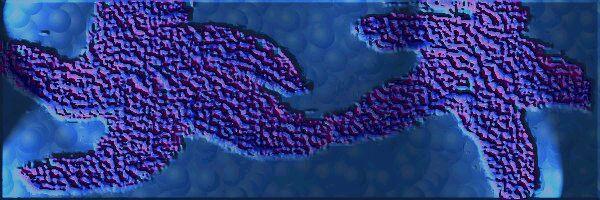BY LETTER
Streyas
 Image from Steve Bowers |
The Streyas are a provolve clade that traces its origins to Old Earth before the interstellar expansion. The first modified starfish were subsentient workers, created for underwater construction tasks, developed in the 500's AT. Streyas were eventually provolved to full sophonce in 1445, during the Middle Federation Era. They are among the most prominent clades derived from an echinoderm species.
Streyas are based on a species of starfish from Old Earth (Pisaster giganteus according to ancient records). When the subsentient worker s were provolved, the designers avoided adding human traits to the animal genome. All of the provolved capabilities, including a much enlarged nervous system and a much more active circulatory system, are refinements or enhancements of existing traits from the baseline species. The provolves have an arm span of 1.7-2.4 meters; slightly more than three times the size of the unmodified species, and masses ranging from 25-40 kilograms. There is no significant size difference between the sexes. Streyas have five muscular arms (the "muscles" actually being a refinement of the original species' hydraulic system). The skin is mottled brown, yellow and orange, with blue rings at the bases of the regularly spaced dermal spines. Streyas retain the dietary habits of their subsapient ancestors, feeding on mussels, clams and snails. Some of the dermal spines are modified pedicellariae: pincer-like appendages that the baseline species used for defense against predators or to deter smaller animals from attaching to the starfish's body. Streyas retain these functions and can also use clusters of pedicellariae for simple manipulation. Locomotion is accomplished mainly via tube feet, as in the baseline species. These tube feet are also the primary manipulative appendages. The test — an articulated skin-covered exoskeleton that Streyas inherited from their ancestors — acts as light armor against impacts, lacerations and punctures.
The water vascular system that unmodified starfish use for musculature and locomotion is still present in Streyas. They are capable of exerting considerable force with their arms. They can also generate suction in their tube feet; this allows them to cling to almost any surface. The suction is so strong that a Streya is almost impossible to pry loose once set in place. Even beings as strong as Sufants are unable to lift a Streya who doesn't want to be picked up. Streyas are equally tolerant of pressures near the ocean's surface or at extreme depths. An excretory system (baseline echinoderms lack one) developed from the water vascular system allows Streyas to survive varying salinities, but they can only tolerate fresh water for a few hours at a time.
Provolution to sapience consisted of adding large nerve clusters (one for each arm) as a neural net. This arrangement allows parallel processing and enhanced redundancy of brain functions. Three secondary nerve clusters per arm perform some motor control functions, thereby leaving the primary neural net free for higher brain activity. Streyas have subjective mind speeds and nerve conduction velocities comparable to those of human baselines, but having five brains allows the provolves to multitask easily. The changes to the nervous and sensory system give Streyas greater visual acuity than that of the baseline species, but they are still nearly blind by human standards. Touch and smell are Streyas' main senses, and both faculties are superhumanly acute. Streyas share their ancestors' ability to regenerate lost limbs. They suffer some loss of intelligence if they lose a primary neural node, but they remain sapient as long as they still have at least three fully functional brains.
Like all starfish, Streyas are marine creatures; they breathe water and can only survive briefly out of it (they can store several minutes worth of breathable water in their water vascular systems, however). Their hydraulic muscles operate much more slowly than electrochemical systems; a Streya's reflexes are less than half as fast as a human baseline's even after provolution enhancements. Streyas also suffer from the limited lifespan issues common to provolves; they typically live for about 40 standard years barring accident, incident or medical intervention. Living in a marine environment also precludes many forms of mechanical enhancement, but Streyas can accept biotech implants.
Streyas are broadcast spawners like their animal ancestors. They reproduce by releasing huge quantities of gametes into the ocean to meet by chance. This mode of breeding has had a tremendous influence on their culture. Because infants go through a nonsentient planktonic phase the adults have no sentimental attachment to them. Not until children grow large enough to develop intelligence are they considered members of the species with full rights. Even then, only those who survive long enough to find their way home have any hope of being taken in -- Streyas make no effort to find their wayward offspring. Nothing short of universal genetic testing could reliably match children with their biological parents, so young are raised in communal creches. Streyas also have no concept of marriage and don't really understand humanoids' preoccupation with copulating. Every year during the breeding season each community holds a week long festival during which all members of breeding age gather on the communal spawning grounds. Streyas regard every member of the opposite sex as a spouse and every member of the same sex as a sibling. This leads to a communistic idea of property rights; everything belongs to the entire community. Most know better than to extend this attitude to other species
All Streya communities celebrate one other holiday in addition to the Festival of Continuance. Freedom Day commemorates the anniversary of the clade gaining full sapients' rights. No Streya will work on Freedom Day in honor of their clade's emancipation from forced labor. Many other provolve clades also celebrate this holiday, but not necessarily on the same day that Streyas do.
Appears in Topics
Development Notes
Text by Michael Walton
Initially published on 19 November 2004.
Initially published on 19 November 2004.






